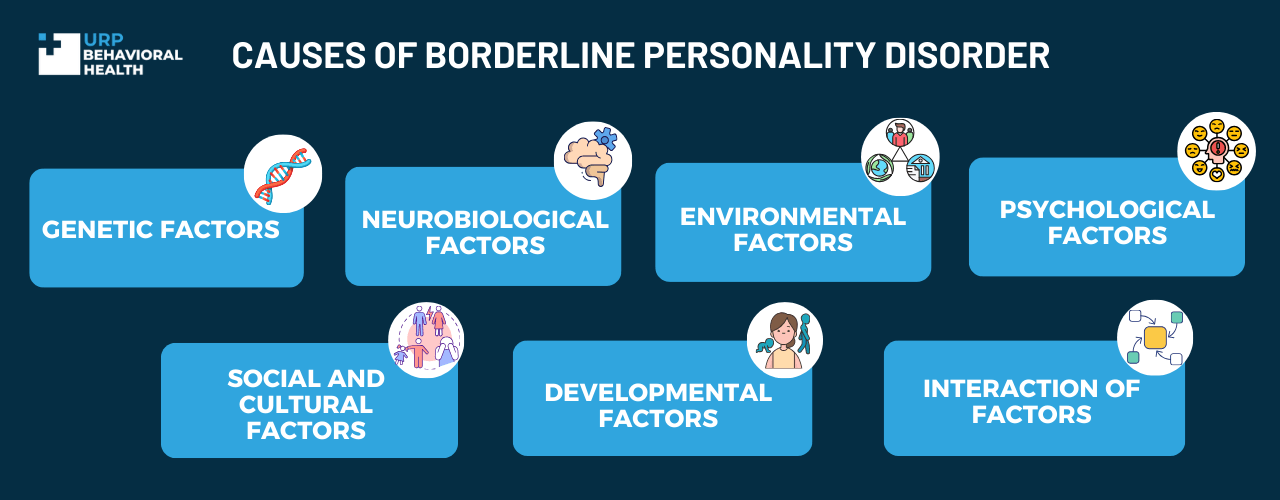Causes of Borderline Personality Disorder

Every mental disorder is linked to some degree of dysfunction and distress, but some conditions are attributed to a higher risk of suicidal behavior. This includes borderline personality disorder, a cluster B personality disorder that’s marked by a pattern of instability in self-image, affect, and interpersonal relationships. Moreover, mental health practitioners view BPD as being highly difficult to treat, mainly due to the risk of co-occurring conditions. Considering how stressful it can be for people, it’s worth taking a look at the possible causes of BPD.


What Causes BPD?
Genetic Factors
According to the DSM-5, you’re five times more likely to develop BPD if you have first-degree biological relatives with the disorder. In fact, recent research shows that the development of BPD has a genetic component. Researchers explain that the genes DPYD and PKP4 can increase your risk of developing the condition. The genome-wide association study of BPD also shows that there’s a genetic overlap between other conditions like bipolar disorder, schizophrenia, and major depression.
Keep in mind that these genes don’t mean that you will develop the condition. It just means that you have a higher likelihood than someone who isn’t related to a person with BPD. In another study, the estimated heritability of the disorder is around 40 percent among first-degree relatives.
Neurobiological Factors
In some cases, the structure of your brain can increase the risk of BPD. A link that’s based on neuroimaging studies including participants with BPD. In recent years, most research surrounding the biological basis of disorders, including BPD, involves visualizing the brain’s structure and function using neuroimaging.
Results have shown a marked difference in the activity and volume of brain structure involved in emotion and impulsivity compared to people who don’t have BPD. For instance, the results of one study indicated that people with BPD have lower hippocampus volumes, especially among participants who had experienced childhood abuse. Similarly, MRI findings show that people with BPD experience increased activity in the left amygdala and left hippocampus while processing negative emotional stimuli.
Environmental Factors
The biosocial model by Marsha M. Linehan is the leading model to explain the etiology of BPD and how people develop emotional dysregulation. According to this etiological model, exposure to an invalidating familial environment can increase the possibility of developing the condition. This includes chaotic families that lack a sense of stability and fail to provide a child with time or attention. It also includes what some refer to as ‘perfect families,’ where there’s little tolerance for displays of negative emotion.
But perhaps the most prevalent environmental factor is exposure to abuse or neglect as a child. Researchers have consistently linked these experiences to a higher risk of BPD. Childhood trauma can impair the development of emotional regulation skills and a healthy attachment. Such factors can interact with genetic predispositions and lead to poor interpersonal functioning and emotional regulation.
Another aspect to consider is that having a higher genetic risk also increases your exposure to environments that could potentially trigger BPD. For instance, if your parent struggles with BPD, substance use disorder, or any other condition, you’re exposed to unhelpful coping strategies and relationship patterns.
Psychological Factors
Certain psychological traits can act as risk factors for BPD, making you more likely to develop the condition. For instance, features like low self-efficacy, poor impulse control, and emotional dysregulation can exacerbate preexisting dispositions.
Similarly, negative thoughts, rumination, and poor reasoning can contribute to the development of symptoms like fear of abandonment. Additionally, the Substance Abuse and Mental Health Services Administration and different studies list sexual and physical abuse as psychological risk factors for BPD.
This also includes your temperament, which refers to how you react to the world. Certain temperamental traits, like emotional instability and impulsivity, have a higher association with BPD, making them potential risk factors.
Social and Cultural Factors
Studies show that certain social and cultural factors, like being from a low socioeconomic background, can exacerbate BPD features. Similarly, living in a neighborhood with a higher rate of violent crime, living through an economic crisis, and losing your job are stressful events that lead to unhelpful ways of coping. There’s evidence that exposure to stress can exacerbate preexisting genetic factors.
When you have a genetic predisposition, you’re highly sensitive to stress and have a lower tolerance to stressors like having a demanding job, being in debt, or living with an abusive partner. Therefore, exposure to chronic stress through societal elements can reduce well-being and increase the likelihood of developing BPD.
Developmental Factors
According to the American Psychological Association, developmental factors refer to variables and conditions that impact your emotional, physical, and intellectual development from conception to maturity. One of the most important developmental factors that are researched in BPD is parental attachment and parenting style.
Research shows that BPD symptoms, specifically emotional dysregulation and unstable self-image, are associated with early parenting. The different types of attachment styles include secure, insecure, ambivalent, and disorganized attachment. Some of these styles are linked to psychopathology, with researchers finding a link between insecure attachment style and BPD. For instance, one study found that insecure attachment was associated with maladaptive strategies for affect regulation, a common feature of BPD.
Interaction of Factors
The above-mentioned risk factors lay out many of the potential causes of BPD. However, it’s important to remember that these factors don’t act in a vacuum. Rather, they interact with each other. This happens when you have a genetic predisposition to BPD and are exposed to highly stressful life experiences, something that’s likely due to temperamental factors. You’re much more vulnerable to developing the condition when you go through traumatic experiences and have neurobiological differences.
Despite these factors, treatment is still possible. Studies have found that approaches like dialectical behavior therapy and other forms of psychotherapy are linked to better emotional regulation and a lower risk of hospitalization. By seeking professional help, you take the first step towards learning better ways of coping with your emotions, responding to stressful events, and building meaningful relationships.
Conclusion
Understanding the causes of Borderline Personality Disorder (BPD) reveals the complex interplay of genetic, neurobiological, environmental, psychological, social, and developmental factors. BPD often emerges from a combination of these influences rather than a single cause. Genetic predisposition, brain structure abnormalities, childhood trauma, and adverse environmental conditions all contribute to the risk. However, these factors interact and amplify one another, making BPD a multifaceted disorder. Despite these challenges, effective treatments like Dialectical Behavior Therapy can significantly improve emotional regulation and overall well-being. Seeking professional help is crucial, and at URP Behavioral Health, our expert team is ready to support you. Contact us to start your journey toward better mental health and a more stable life.
Let us guide you towards healing
We know that seeking treatment can be overwhelming, but our staff is here to make the process as smooth as possible. We’re available 24/7 to address any questions or concerns you may have.

